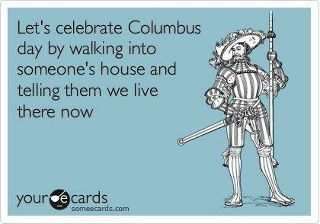Christopher Columbus — First Illegal Alien
This post first appeared on this blog in October 2013. I will repeat it every “Columbus Day” until this holiday is nationally changed to Indigenous People’s Day, following the lead of Berkeley, California, Seattle, Washington and Minneapolis, Minnesota. I do not believe we should be celebrating a murderer and slave trader.
 Imagine a foreign-speaking stranger walked into your house one day, claimed it was now his and threw you out, or even enslaved or killed you and your family.
Imagine a foreign-speaking stranger walked into your house one day, claimed it was now his and threw you out, or even enslaved or killed you and your family.
Would you celebrate him with a national holiday?
Neither would I.
Yet the United States and other countries in the West continue to celebrate Christopher Columbus as having discovered the “New World” even though there was a perfectly marvelous civilization already living here.
[Columbus Day in 2014 is Monday, October 13 – a Federal holiday.]My Lakota dad Wallace Black Elk called Columbus “the first illegal alien.”
Native Americans had been living fulfilling lives on this continent for thousands of years before Columbus’ arrival. Or, as author Kurt Vonnegut put it, “1492 was simply the year sea pirates began to rob, cheat and kill them.”
Schools today are finally teaching children that Columbus and his men enslaved native inhabitants of the West Indies when they first arrived. That’s a step in the right direction because when I was in school, I wasn’t taught that truth.
So why do we still celebrate him?
The events of 1492 and beyond
The voyage during which Columbus stumbled upon North America was actually a commercial expedition. Because the spice trade had become expensive by having to transport over land, he was seeking a water route to the Far East.
As we all know from our school days, Columbus was financed by King Ferdinand and Queen Isabella of Spain and set off in three ships: the Nina, Pinta and Santa Maria.
After a month, Columbus and his crew were frustrated and ready to turn around when they suddenly saw land: an island in the Bahamas. Columbus thought he was in the East Indies and called the inhabitants Indians.
However, another version of the origin of the name “Indian” is that Columbus recognized that these people were “of God” – in Dios. Which became “Indian.”
He recognized their gentle nature: in a letter to one of his patrons, he wrote:
“They are artless and generous with what they have, to such a degree as no one would believe but him who had seen it. Of anything they have, if it be asked for, they never say no, but do rather invite the person to accept it, and show as much lovingness as though they would give their hearts.”
Right after making that observation, Columbus offered to send back as many slaves as requested.
Columbus wrote in his journal: “with fifty men they can all be subjugated and made to do what is required of them.”
After his second voyage, Columbus returned to Spain taking gold, parrots and Native American slaves.
By 1514, the Spanish conquerors gave an ultimatum that the Natives must convert to Christianity or be enslaved and “we shall take away your goods, and shall do all the harm and damage that we can.”
Columbus made three more trips to the “new world” but felt like a failure for not having found the new shipping route for spices he’d been seeking.
Legend has it that he died in 1506 a disappointed man.
Brave? Yes
The first? No
Christopher Columbus was not the first European to arrive in North America
The Vikings were here 500 years before Columbus. According to historical documents now confirmed by archeological findings, Vikings sailed across the Atlantic and reached the northeast coast of North America in 1000 AD. There are remains of an early 11th Century Norse village in Newfoundland.
The Irish Monk St. Brendan the Navigator reached North America in the 6th Century. The account of his journey was published some 300 years later in Navigatio Sancti Brendani [Travels of St Brendan].
But these early explorers were polite, and left only footprints and took only memories, to paraphrase a famous instruction for visiting new land.
If Columbus had the same sensibilities as the Vikings and St. Brendan, the world would likely be a very different place today.
Once again, I invite you to share with your children the true history of Native Americans in this country.
Sources: http://www.understandingprejudice.org/nativeiq/columbus.htm#source11
Hanke, L. (1949). The Spanish struggle for justice in the conquest of America. Philadelphia, PA: University of Pennsylvania Press.
Molly Larkin is the co-author of the international best-seller “The Wind Is My Mother; The Life and Teachings of a Native American Shaman” and other books on health. She is passionate about helping people live life to their fullest potential through her classes, healing practice and blog at www.MollyLarkin.com

